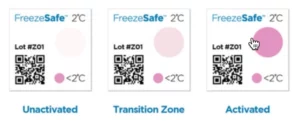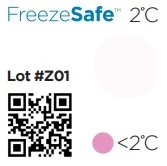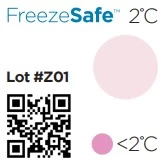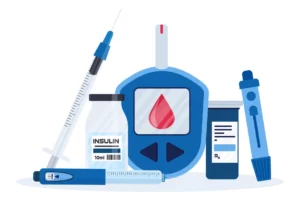Freeze Indicator Case Study
 The SpotSee FreezeSafe™ indicator provides accurate evidence if a product has experienced unacceptably low temperatures. This cost-effective solution allows you to add an indicator to every shipment or mount directly onto the product. Easy to use, FreezeSafe turns from white to magenta when the temperature falls below its threshold. A simple visual check alerts the recipient of the indicator is performed, it alerts the recipient if the temperature has been unacceptably cold.
The SpotSee FreezeSafe™ indicator provides accurate evidence if a product has experienced unacceptably low temperatures. This cost-effective solution allows you to add an indicator to every shipment or mount directly onto the product. Easy to use, FreezeSafe turns from white to magenta when the temperature falls below its threshold. A simple visual check alerts the recipient of the indicator is performed, it alerts the recipient if the temperature has been unacceptably cold.
Product Solution: FreezeSafe Indicator

Freeze Indicator Case Study
|
Company Profile Industry: Pharmaceutical Application: Cold chain temperature monitoring Challenge: The security of knowing if any products have frozen during transport |

Unactivated |

Transition Zone |

Activated |

New Freeze Indicator Spots Frozen Drugs for Better Safety
Freezing isn’t good for many pharmaceutical products, so pharmacies, caregivers and, increasingly, patients, need a way to know whether their products froze in transit. SpotSee’s new freeze indicator provides that information.
Despite some vaccines needing frozen or deep-frozen temperatures, many vaccines, biologics and other medicines can be ruined by freezing. HUMIRA® (adalimumab) a treatment for ulcerative colitis, and Pradaxa (dabigatran), an anticoagulant pill, are two of many possible examples. Some, like insulin (used to treat the approximately 29 million Americans with diabetes) can become completely ineffective or even deadly when frozen.
Drug developers and distributors go to great lengths to use the proper protective packaging when shipping therapeutics and diagnostics, but sometimes those materials fail, are damaged or aren’t used properly.
One large pharmaceutical logistics provider detailed such an event at a conference a few years ago. A warehouseman was hypervigilant about maintaining refrigerated temperatures for a particular cold-chain package, so he placed it in the refrigerator until the carrier arrived. That drop in temperature was enough to cause the contents to freeze, ruining the therapeutic.
Clearly, accidents happen.
With telemedicine, more and more medications and diagnostics are being shipped directly to patients’ homes and – for diagnostics, from the home to a lab. Prior to the Covid-19 pandemic, the ship to home market for medications was expanding and that growth has continued ever since. This means therapeutics, assays and patient samples (such as blood or other fluids ) may be exposed to cold temperatures as they shuttle the last mile or around the country, sitting in cargo hold, porches or mailboxes.
Infusion pharmacies and clinics, distributors, hospitals, physicians’ offices and retail pharmacies all need to ensure no accidents affect their products, whether incoming or outgoing. They and their patients need to be assured that products that must not be frozen did not freeze at any point throughout the supply chain, thus ensuring that those therapeutics, vaccines or diagnostics are as beneficial now as when they were manufactured.

Unfortunately, freezing isn’t always evident. Drugs may freeze and thaw during shipping without anyone knowing. While some become cloudy, many others have no visible signs of having frozen. Consequently, not even pharmacists can look at a drug and know whether it froze and thawed before they received it.
For these reasons, SpotSee created the FreezeSafe product line. FreezeSafe single-use indicators clearly show
whether unacceptably low temperatures have occurred at any point between the time the indicator was affixed to the product and the time it arrived.
When these indicators change color from white to magenta, patients, pharmacists or others can see at a glance whether temperatures dropped to dangerously low levels. To trigger the color change, the temperature must fall below 2°C for 90 minutes, or 0°C – freezing – for 60 minutes. SpotSee’s new freeze indicators are accurate to +1°C.
These new freeze indicators were designed in a format that fits easily on life science products, while still including the information that is important to SpotSee’s customers. And, because they are flat, manufacturers can continue to use their usual packaging materials. This low-cost freeze indicator is self-adhesive, so users only need to peel off the protective backing and stick the indicator onto the product or into the shipment.
SpotSee’s FreezeSafe are launching now as individual indicators and as part of the SpotSee Cold Chain Complete which shows excursions when temperature is both too cold and too hot.

Unactivated |

Transition Zone |

Activated |
To learn more about how SpotSee’s new freeze indicator can help protect your cold chain, contact SpotSee.
Contact us with any questions you have about this case study or to schedule a meeting with a SpotSee operations expert!

